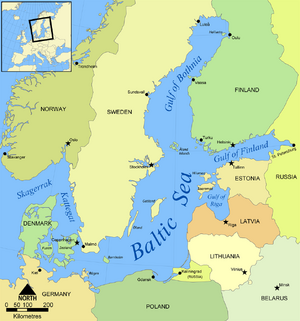Baltic Sea
| Author:Laxman Burdak, IFS (Retd.) |

Baltic Sea is a brackish mediterranean sea located between Central and Northern Europe.
Location
It is bounded by the Scandinavian Peninsula, the mainland of Europe, and the Danish islands.
Origin of name
Some Swedish historians believe the name derives from the cripple secondary god Balder of Nordic mythology. According to Ram Swarup Joon Baldeer was a Jat leader.[1]
History
Ram Swarup Joon writes in History of the Jats/Chapter III:
The name Scandanavia has been derived from Sikandh Nabh, Todd, while quoting Triner, writes that the Angle Saxons were Shah Nag Vanshi Jattias or Uties. After invading Scandanavia they founded Jutland. Todd writes that the greatest community of Scandanavia was Shiva Vanshi Jats. The customs of Sati and Johar were common amongst them and they had brought these with them from India. The non-Jat Population of Jut land used to call these customs barbarous.
On the death of Baldeer, a Jat leader, his elder wife Nanna was allowed the right to perform Sati but his younger wife Udan was not allowed the honour.
Quoting Herodotus Todd writes that these people 'worshipped according to Indian customs and swore on their weapons. They named their capital Asgarh. It is of interest that the ancient name of Hansi in Hissar district of Haryana was also Asgarh.
They considered the sight of certain birds as a good omen. Herodotus and Strabo agree that in about 2000 BC, the Jati community lived in Jutland. They built a temple there dedicated to their Goddess Ahilya. Her abode was in the garden and a cow drew her chariot. They also built the temple Apsala. The name of their God was Oven, which meant Budha the forefather of Chandra Vansh.
"NE Euro" fractions in DNA samples of Jats
In August 2013, the geneticist Razib Khan wrote in an article for the Discover Magazine:
- "Finally let's move to North India, and the zone stretching between Punjab in the Northwest and Bihar in the East. Though in much of this region Brahmins have higher "NE Euro" fractions, this relationship seems to breakdown as you go northwest. The Jatt community in particular seems to have the highest in the subcontinent. There are inchoate theories for the origins of the Jatts in Central Asia. I had dismissed them, but am thinking now they need a second look. The reasoning is simple. The Jatts of the eastern Punjab have a higher fraction of "NE Euro" than populations to their northwest (Pathans, Kalash, etc.), and Brahmin groups (e.g., Pandits) in their area who are theoretically higher in caste status. This violation of these two trends implies something not easily explained by straightforward social and geographic processes. The connection between ancestry and caste status also seems to break down somewhat in the Northwest, as there is a wide variation in ancestral components."[2]
Jat connections
Bhim Singh Dahiya[3] writes that Jats are known as Goths in Gothland in the Baltic sea.
Hukum Singh Panwar (Pauria)[4] tells us that The descendents of the Nordics are confined not only to the North west India and Pakistan, but are also found in the Baltic and Scandinavian countries, the Netherlands and the Great Britain. The eastern Nordics i.e. the Jats are much higher in B than in A whereas the West-European Nordics are much higher in A than B (See -The Jats:Their Origin, Antiquity and Migrations/Appendices/Appendix No.3) As we have already pointed out, the most convincing illustration of such, a separation of certain groups from the common 'ancestral stock is that of the ancient Anglo-Saxons, Teutonic Goths, Jutes, Danes, Vilkas (Virkas) etc. in very remote prehistoric times[5]. It is, therefore, hardly surprising that, on account of resemblance of facial features, to a European the Jats look European and unmistakably Vice versa.
External links
References
- ↑ Ram Swarup Joon:History of the Jats/Chapter III
- ↑ Author: Razib Khan. Article: What the Harappa Ancestry Project has resolved. Magazine: Discover Magazine. Published: 04 August 2013.
- ↑ Bhim Singh Dahiya: Jats the Ancient Rulers (A clan study)/The Jats,p.25
- ↑ The Jats:Their Origin, Antiquity and Migrations/An Historico-Somatometrical study bearing on the origin of the Jats,pp.128-129
- ↑ MacNeish, RS., "Early Man in the Andes", Scientific America, 224, 1971, pp. 36-64. According to C-14 test, modern man reached W. Hemisphere 40,000 to 100,000 years ago, in Canada 23,000 to 28,000 B.C.;Garn, op. cit., pp. 128. See also Suniti Kumar Chatterji, Balts and Aryans, Simla, 1968, Ch. XII. Panchanan Mitra, Prehistoric Ind., Delhi, 1979, pp. 49-50, 229.

